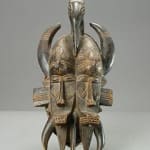Senufo Wooden Double Kpeliye’e Mask, 20th Century CE
Wood
15.75
PF.5971
Further images
Senufo men have their own 'secret' societies, called the Poro, headed by the village elder, in which the sacred knowledge of manhood is taught to young initiates. Before they are...
Senufo men have their own "secret" societies, called the Poro, headed by the village elder, in which the sacred knowledge of manhood is taught to young initiates. Before they are taken into the wilderness to learn the clan wisdom, prospective adolescent are symbolically "killed" to signify the end of their childhood. Upon their return, they are welcomed back into the village as adults with an elaborate ceremony.
The most beautiful element of this ceremony is the celebration of the interdependent relationship between man and woman. Young men newly initiated into Poro society wear masks similar to this Kpeliye’e mask. To garner the appreciation of women, these young men, dressed in full, colorful costumes of cloth and raffia to complement their masks, prance gracefully in a masquerade to the beat of pounding drums and dazzling rattles.
This Kpeliye’e mask is a rare double-headed example, perhaps influenced by the masks of the Baule tribe who are noted for their fine bicephalous masks. It represents, as all Kpeliye’e masks do, a beautiful, idealized woman (in this case, women). The two faces are joined side by side while the protrusions typical of such masks fall on either side. These projections are said to represent ears while another clearly depicts animal horns. The large central crest is replaced by a long-necked bird that stands on top of the masks and burrows its head in between the two domed foreheads. On either side of the protruding mouths, with pointed teeth visible, spring two curved forms. The Senufo themselves explain that these might represent tassels of hair, or perhaps even legs. To the Senufo, this masks was representative of the wisdom of the sexes (twice as potent in this example), a knowledge we continually struggle to understand today.
The most beautiful element of this ceremony is the celebration of the interdependent relationship between man and woman. Young men newly initiated into Poro society wear masks similar to this Kpeliye’e mask. To garner the appreciation of women, these young men, dressed in full, colorful costumes of cloth and raffia to complement their masks, prance gracefully in a masquerade to the beat of pounding drums and dazzling rattles.
This Kpeliye’e mask is a rare double-headed example, perhaps influenced by the masks of the Baule tribe who are noted for their fine bicephalous masks. It represents, as all Kpeliye’e masks do, a beautiful, idealized woman (in this case, women). The two faces are joined side by side while the protrusions typical of such masks fall on either side. These projections are said to represent ears while another clearly depicts animal horns. The large central crest is replaced by a long-necked bird that stands on top of the masks and burrows its head in between the two domed foreheads. On either side of the protruding mouths, with pointed teeth visible, spring two curved forms. The Senufo themselves explain that these might represent tassels of hair, or perhaps even legs. To the Senufo, this masks was representative of the wisdom of the sexes (twice as potent in this example), a knowledge we continually struggle to understand today.





